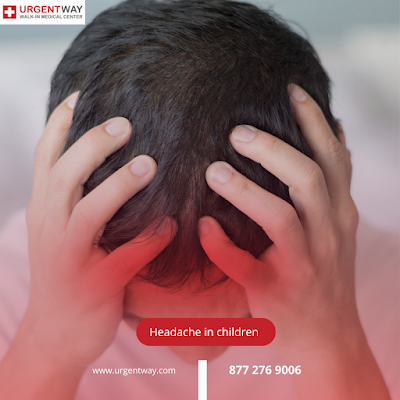Headache in children: What to know
Headaches are not uncommon in children, and they can have various causes. It's important to understand that a headache in a child can be distressing both for the child and the parent. If your child is experiencing headaches, it's advisable to consult a healthcare professional for a proper evaluation and diagnosis. In the meantime, here are some common causes and types of headaches that can occur in children:
- Tension headaches: These are the most common type of
headaches in children and adolescents. They are often described as dull,
aching pain on both sides of the head and may be caused by stress,
anxiety, poor posture, or inadequate sleep.
- Migraines: Migraines can also affect children, although
they may present differently compared to adults. Migraines in children can
cause intense, throbbing pain, often on one side of the head. They may be
accompanied by other symptoms such as nausea, vomiting, sensitivity to
light or sound, and stomach pain.
- Sinus headaches: Sinus infections or allergies can
cause headaches in children. These headaches are usually associated with
other symptoms like nasal congestion, facial pain, or a low-grade fever.
- Cluster headaches: Although rare in children, cluster
headaches can occur. They are characterized by severe, one-sided pain
around the eye or temple, often accompanied by eye redness, tearing, and
nasal congestion. Cluster headaches tend to occur in clusters over several
weeks or months, with periods of remission in between.
- Headaches related to illness or fever: Some children
may experience headaches as a symptom of an illness such as the flu or a
viral infection. These headaches often resolve once the underlying illness
is treated.
It's important to note
that this is not an exhaustive list, and there can be other causes for
headaches in children. A healthcare professional will be able to assess your
child's symptoms, and medical history, and perform a physical examination to
determine the underlying cause of the headaches. They may also recommend
additional tests if necessary.
In the meantime, you
can try to help your child manage headaches by ensuring they get enough rest,
maintaining a regular sleep schedule, encouraging hydration, managing stress
levels, and providing a quiet and calm environment. Avoiding triggers such as
certain foods, bright lights, or loud noises may also be beneficial in some
cases. However, it's best to consult with a healthcare professional for
personalized advice based on your child's specific situation.
When it comes to
headaches in children, there are several important factors to consider. Here's
what you should know:
- Prevalence: Headaches are common in children, with
studies suggesting that around 60% of children will experience a headache
by the age of 18. However, the frequency, severity, and impact of
headaches can vary from child to child.
- Types of headaches: Children can experience different
types of headaches, including tension headaches, migraines, sinus
headaches, cluster headaches, and headaches associated with other medical
conditions or infections.
- Symptoms: Headaches in children can present differently
compared to adults. Children may have difficulty expressing their
symptoms, so it's essential to pay attention to their behavior. Some
common signs of a headache in children include irritability, restlessness,
loss of appetite, avoidance of light or noise, rubbing or pressing on the
head, and changes in sleep patterns.
- Triggers: Identifying triggers for your child's
headaches can help manage their condition. Potential triggers may include
stress, lack of sleep, certain foods or drinks, dehydration, changes in
routine, environmental factors (e.g., bright lights, strong smells), and
hormonal changes (particularly in adolescents).
- Seeking medical evaluation: If your child frequently
experiences headaches, experiences severe or worsening headaches, has
accompanying symptoms like vomiting or neurological changes, or if the
headaches significantly interfere with their daily activities, it is
recommended to consult a healthcare professional. They can conduct a
thorough evaluation, review your child's medical history, and provide
appropriate guidance and treatment options.
- Treatment options: Treatment for headaches in children
may vary depending on the underlying cause and individual circumstances.
Depending on the severity and frequency of headaches, treatment may
involve lifestyle modifications (such as maintaining regular sleep
patterns and managing stress), over-the-counter pain relievers (if
appropriate for their age), or prescription medications prescribed by a
healthcare professional.
- Prevention strategies: Along with treatment, there are
preventive measures that can help reduce the occurrence of headaches in
children. These may include ensuring your child gets enough sleep,
maintaining a healthy diet, managing stress levels, staying hydrated,
promoting regular physical activity, and establishing consistent routines.
If you or your child
are experiencing headaches and are seeking medical attention, it may be
appropriate to visit pediatric urgent care like UrgentWay. They can assess your
symptoms, perform a physical exam, and provide appropriate treatment.




Comments
Post a Comment